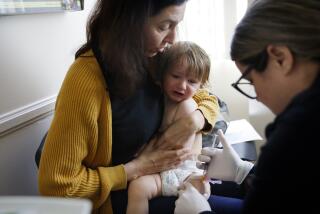Study shows clusters of under-immunization in Northern California
As a measles outbreak spreads rapidly across Southern California and beyond, scientists have identified clusters of under-immunization in communities in 13 counties in the northern portion of the state.
Poring over electronic medical records of children who received care in the Kaiser Permanente Northern California system and mapping the data to home addresses, health plan researchers found five statistically significant hotbeds of under-immunization — locations where relatively higher percentages of children missed one or more recommended vaccine doses.
Knowing precisely where such pockets of under-vaccinated populations are could help physicians and public health departments prevent illnesses such as the measles cases emerging from Orange County, said Dr. Tracy Lieu, a pediatrician and director of the Kaiser Permanente Division of Research in Oakland.
“To the extent that we can identify these hot spots early on, it may help us to identify emerging epidemics sooner,” said Lieu, lead author of the study, published online Sunday night by the journal Pediatrics.
The data revealed under-immunization clusters among children who turned 3 between 2010 and 2012 in the East San Francisco Bay from Richmond to San Leandro; in Sonoma and Napa counties; in an area between Sacramento and Roseville; in northern San Francisco and southern Marin counties; and in Vallejo.
Shot limiting, the practice of delaying vaccinations instead of following the recommended schedule, was clustered in San Francisco, the East Bay from Berkeley to Alameda, Marin County and southwestern Sonoma County.
Outright vaccine refusal clustered in the East Bay from El Cerrito to Alameda, in Marin and southwestern Sonoma counties, in northeastern San Francisco, in northeastern Sacramento County and Roseville and south of Sacramento.
Higher percentages of residents with graduate degrees increased a neighborhood’s odds of under-immunization — but so did higher percentages of households with incomes below the poverty line.
A number of factors may have been at work, Lieu said. People in highly educated communities may actively opt out of vaccines, believing that immunizations may cause autism or that administering too many at once might overwhelm children’s immune systems, despite evidence to the contrary.
Residents of lower-income communities may instead miss doses because it is harder for them to get their kids to medical appointments and comply with the immunization schedule.
Rates of under-immunization rose over the years of the study, which examined medical records from 154,424 children born between 2000 and 2011, from 8.1% in 2002-05 to 12.4% in 2010-12.
The ability to collect the immunization data from electronic medical records offered researchers “a much earlier read and much finer-grained detail” on where pockets of under-vaccination may emerge, Lieu said.
“Vaccine refusal is kind of like politics — it’s all local,” said Dan Salmon, an immunization researcher and deputy director of the Institute for Vaccine Safety at the Johns Hopkins Bloomberg School of Public Health in Baltimore. “It doesn’t matter how low the refusal rate is in the state. If one out of the three kids your child is in contact with isn’t vaccinated, your child is at risk.”
Salmon, who was not involved in the Kaiser study, said the researchers’ approach represented an advance over earlier studies because Kaiser’s electronic records system documented when parents had actively refused immunizations — a detail missing from routine surveys of preschool children.
He said the Kaiser data also marked an improvement over school vaccine exemption data for entering kindergartners that are often studied because the medical records let researchers analyze immunizations trends for particular vaccines. “These are the most compelling data I have seen that have shown that the rates of parents refusing and delaying vaccines is increasing,” he said.
Researchers are discussing repeating the analysis among patients in the health system’s Southern California region, a Kaiser Permanente spokesman said Friday.
As of Saturday, the Orange County measles outbreak had sickened 51 people in four states and Mexico, The Times reported.
Most of the ill had not been fully immunized.
Twitter: @LATerynbrown
More to Read
Sign up for Essential California
The most important California stories and recommendations in your inbox every morning.
You may occasionally receive promotional content from the Los Angeles Times.











